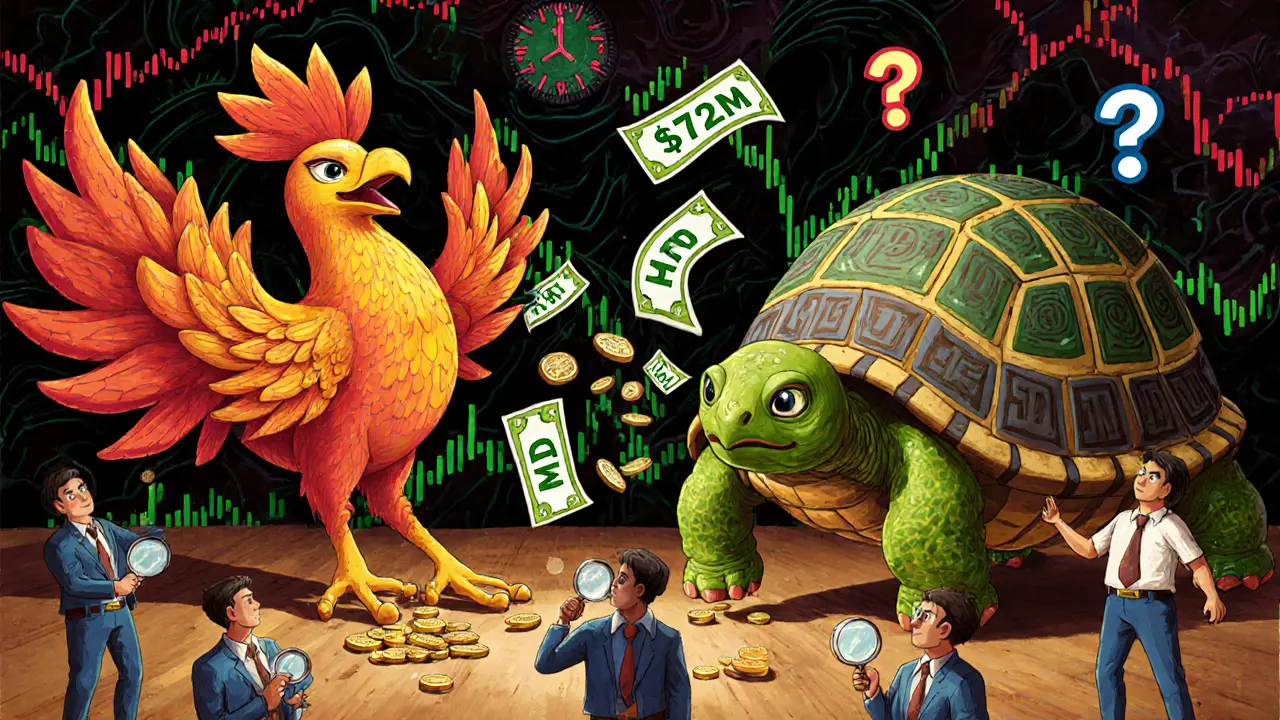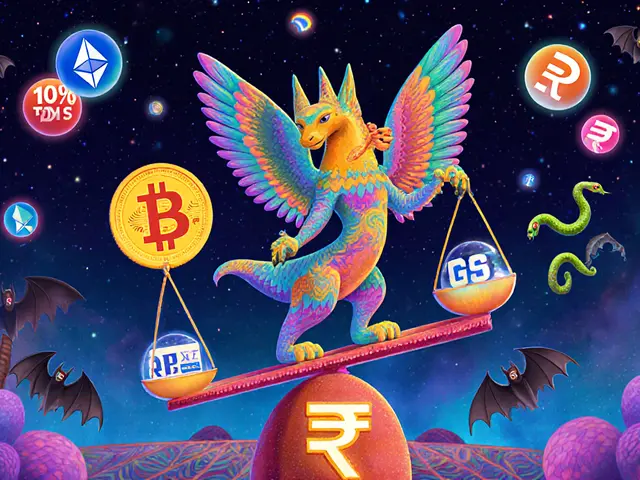Kyo Finance V3 Reward Calculator
Estimate Your Rewards
This calculator estimates potential rewards based on Kyo Finance V3's claims of "real-time staking." Note: Kyo Finance V3 has no published audits or whitepaper, and the calculation method is unverified. This is for educational purposes only.
Estimated Rewards
Enter your values above and click calculate to see estimated rewards.
Critical Considerations
- No Audits There are no published security audits - Kyo Finance V3 smart contracts have not been reviewed by third-party security experts.
- Unverified Claims "Sustainable LP yield" system is unverified - The platform claims to compensate for impermanent loss, but no technical documentation exists to verify this.
- Volume Discrepancies Trading volume data varies widely - Reports show discrepancies up to 80x, suggesting possible artificial volume inflation.
When you hear "crypto exchange," you probably think of Binance, Coinbase, or even Uniswap. But what if you’re deep inside the Astar Network ecosystem, holding ASTR, vASTR, or ARCAS tokens? Then Kyo Finance V3 might actually be worth a closer look. This isn’t your typical DEX. It’s built on Soneium - Astar’s "superchain" - and claims to have stripped away all the messy parts of ve-tokenomics. But does it deliver? Or is it just another niche project struggling to stand out in a crowded field?
What Exactly Is Kyo Finance V3?
Kyo Finance V3 is a decentralized exchange (DEX) running on the Soneium blockchain, which is tightly linked to Astar Network. It launched on January 1, 2024, with a clear mission: make ve-tokenomics simple. Forget epochs, NFTs, and complicated voting power calculations. Kyo Finance V3 replaces all that with a real-time staking system. If you provide liquidity, you earn rewards immediately - no waiting, no complex math. It’s built on a Uniswap-style automated market maker (AMM) model but with custom tweaks. The platform lists 16 tokens and offers 25 trading pairs. Most of the action happens between stablecoins (USDT, USDC.E) and WETH, or Astar’s native tokens like ASTR and vASTR. If you’re trading ASTR or other Astar ecosystem assets, this is one of the few places where you’ll find decent liquidity.Trading Volume: A Tale of Two Numbers
Here’s where things get messy. Different data trackers report wildly different numbers for Kyo Finance V3’s 24-hour volume. - CryptoMarketCap says $72.8 million - a 29% increase. - CoinGecko says $898,270 - down 58% from the day before. - CoinMarketCap’s spot volume is just over $1 million. That’s an 80x difference. That’s not a glitch. That’s a red flag. In the crypto world, volume discrepancies this large usually mean one of two things: either the data sources are using wildly different methods to calculate volume, or someone’s inflating numbers. Given that Kyo Finance V3 is a small DEX with minimal adoption outside Astar Network, the $72 million figure looks suspicious. Most experts in DeFi forums, like ChainSleuth on CoinGecko’s community board, call volume differences over 50x a sign of wash trading or artificial volume. The $1 million range is more believable - and still tiny. For context, Curve Finance, the original ve-tokenomics leader, does over $1 billion in daily volume. Kyo Finance V3, even at its highest reported number, is less than 1% of that.How Does the ve-Tokenomics Simplification Work?
This is Kyo Finance V3’s biggest claim - and its most interesting feature. Traditional ve-tokenomics (used by Curve, Aerodrome, Solidly) locks up tokens for weeks or months to earn voting power and rewards. You get rewards in installments, and your voting power decays over time unless you renew. It’s complicated. Kyo Finance V3 says: forget all that. Just stake your LP tokens. You get rewards instantly. No epochs. No NFTs. No waiting. The platform calls it a "real-time staking-like mechanism." The idea sounds great - especially if you’re tired of juggling voting cycles. But here’s the catch: they haven’t published the code. No whitepaper. No audit reports. No public smart contract breakdown. They also claim to have a "sustainable LP yield" system that compensates liquidity providers for impermanent loss by working with "aligned arbitrageurs." Sounds fancy. But what does that actually mean? Who are these arbitrageurs? How are they paid? Is there a revenue-sharing model? No one knows. The only source is a single forum post by someone named Kai on Astar Network’s site - which reads like a marketing pitch, not a technical explanation. Until someone can verify how this system actually works, it’s all theoretical. And in DeFi, unverified claims don’t earn trust - they earn skepticism.
Who Is This Exchange For?
Kyo Finance V3 isn’t for everyone. It’s not even for most crypto traders. If you’re holding ASTR, vASTR, ARCAS, or other tokens native to Astar Network, then yes - Kyo Finance V3 is one of the few places where you can trade them with decent liquidity. The top three trading pairs all involve Astar ecosystem tokens. If you’re building something on Astar, or just holding these assets, this exchange has purpose. But if you’re trading Bitcoin, Ethereum, Solana, or even popular altcoins like SHIB or DOGE? Forget it. Kyo Finance V3 doesn’t list them. It’s not designed for that. It’s also not for beginners. You need a Web3 wallet (MetaMask, Rabby, etc.), you need to bridge assets to Soneium (which isn’t automatic), and you need to understand what liquidity pools and impermanent loss even mean. There’s no educational content on the site. No tutorials. No FAQs beyond a one-paragraph summary.User Experience and Support
The interface is clean. Simple. Fast. That’s the only consistent positive from the few user comments on Astar’s forum. One user called it "very user-friendly and convenient" - but that was in January 2024, right after launch. Since then, there’s been almost no feedback. No reviews on Trustpilot. No ratings on CoinGecko. No mentions on CryptoSlate. Reddit has only 12 posts about it in the last six months - mostly questions about wallet connection issues. Support? There’s a Telegram link on the website. That’s it. No email. No help center. No live chat. If you get stuck, you’re on your own. And there’s no mobile app. You can’t trade on the go. You need a desktop browser and a Web3 wallet.How Does It Compare to the Competition?
Let’s put Kyo Finance V3 next to the big players: | Feature | Kyo Finance V3 | Curve Finance | Aerodrome Finance | |--------|----------------|---------------|-------------------| | Blockchain | Soneium (Astar) | Ethereum | Polygon | | Trading Pairs | 25 | 350+ | 150+ | | 24h Volume (highest reported) | $72.8M (disputed) | $1.14B | $133M | | Token List | 16 | 350+ | 100+ | | ve-tokenomics | Simplified real-time staking | Complex epochs + voting | Epochs + voting | | LP Reward Model | Claimed impermanent loss compensation | Standard fee share | Fee share + incentives | | Mobile App | No | No | No | | Trust Score | 5 (unverified scale) | 9.2 | 8.7 | Curve Finance dominates. Aerodrome is strong on Polygon. Kyo Finance V3? It’s barely on the map. Even if you take the highest volume number, it’s still less than 1% of Curve’s volume. Its only real edge is simplicity. But simplicity without liquidity, security proofs, or user adoption doesn’t mean much.
Is It Safe?
No audits have been published. No third-party security reviews exist. The smart contracts are live, but they’re not public-facing in any meaningful way. You can’t verify the code yourself. In DeFi, that’s a dealbreaker for most serious users. If you’re risking hundreds or thousands of dollars, you want to know the code has been tested by experts. Kyo Finance V3 offers none of that. The lack of transparency isn’t just a technical issue - it’s a trust issue. And in crypto, trust is everything.Final Verdict: Niche Tool, Not a Mainstream Pick
Kyo Finance V3 isn’t a scam. But it’s not a breakthrough either. If you’re deeply embedded in the Astar Network - holding ASTR, building dApps on Soneium, or just want to trade Astar-native tokens - then yes, Kyo Finance V3 is a viable option. The interface is simple, the fees are low, and the transaction speed on Soneium is fast. But if you’re looking for a reliable, liquid, trustworthy DEX to use daily? Look elsewhere. Curve, Uniswap, or Aerodrome are far safer bets. Even if you’re into ve-tokenomics, those platforms have proven track records, audits, and real user adoption. Kyo Finance V3 feels like a prototype. A bold idea that hasn’t yet been proven at scale. It’s possible it could grow if Astar Network’s "superchain" vision takes off. But right now? It’s a gamble - and not one most people should take.Should You Use Kyo Finance V3?
Use it if: - You hold ASTR, vASTR, ARCAS, or other Astar ecosystem tokens - You want to avoid complex ve-tokenomics systems - You’re comfortable with minimal support and no mobile app - You’re okay with unverified claims and no audits Avoid it if: - You trade Bitcoin, Ethereum, or major altcoins - You need high liquidity or deep order books - You want customer support or educational resources - You value transparency and audits - You’re new to DeFi The bottom line: Kyo Finance V3 is a tool for a very specific audience. Outside that audience, it’s just noise.Is Kyo Finance V3 safe to use?
There’s no public audit or security review of Kyo Finance V3’s smart contracts. While the platform appears to function technically, the lack of transparency means users are trusting code they can’t verify. In DeFi, that’s a high risk. Only use it with funds you’re willing to lose.
Does Kyo Finance V3 have a mobile app?
No, Kyo Finance V3 does not have a mobile app. You can only access it through a desktop browser with a Web3 wallet like MetaMask. There’s no official iOS or Android application.
Why are trading volumes so different across platforms?
The discrepancy - from under $1 million to over $70 million - likely stems from how each platform counts trades. Some include all trading pairs, others only spot trades. But the extreme gap suggests possible wash trading or artificial volume inflation, which is common in smaller DEXs trying to appear more active than they are.
Can I earn rewards just by staking LP tokens?
Yes, according to Kyo Finance V3’s model, staking your LP tokens gives you real-time rewards without epochs or voting cycles. But how those rewards are funded - especially the claim about compensating impermanent loss - remains unverified. There’s no public proof of how arbitrageurs are involved or how revenue is shared.
What tokens can I trade on Kyo Finance V3?
You can trade 16 tokens, mostly centered around the Astar Network ecosystem. The most popular pairs are USDT/WETH, USDC.E/WETH, and USDT/USDC.E. ASTR, vASTR, and ARCAS are also available. You won’t find major coins like BTC, SOL, or DOGE.
How does Kyo Finance V3 compare to Uniswap?
Uniswap supports thousands of tokens, has massive liquidity, and is audited and battle-tested. Kyo Finance V3 supports only 16 tokens, has minimal liquidity, and lacks audits. If you’re trading mainstream assets, Uniswap is the clear choice. Kyo is only relevant if you’re focused on Astar Network tokens.











10 Comments
Kyo Finance V3 is actually kinda cool if you’re deep in Astar land. I’ve been swapping ASTR for vASTR on it for months - fast, cheap, no drama. The volume weirdness? Yeah, probably some wash trading, but the real trades feel legit. 🤘
I love how they simplified ve-tokenomics - no more waiting for epochs! But... where are the audits? I staked $500 and now I’m nervously refreshing the page every 10 minutes. Please, someone, audit this thing!
The volume discrepancy is a huge red flag. $72M vs. $1M? That’s not a data error - that’s a scam signal. In DeFi, transparency isn’t optional; it’s the baseline. If you can’t verify the code, you’re gambling with your capital. And no mobile app? That’s a dealbreaker for most of us.
Oh please. Another ‘revolutionary’ DEX that’s just a glorified script with a fancy name. Kyo Finance V3? More like Kyo Finance Vague. They say ‘real-time staking’ like it’s magic, but the entire model is built on vibes and a single forum post by ‘Kai’ who probably works in marketing. And don’t get me started on the ‘aligned arbitrageurs’ - that’s not a feature, that’s a euphemism for ‘we pump our own pool and call it innovation.’ This isn’t DeFi, it’s a TikTok trend with a wallet.
I tried it last week and honestly? The UI is SO smooth. Like, better than Uniswap on mobile (wait, no mobile… ugh). But the lack of support is wild. I had a tx stuck for 3 hours and no one replied on Telegram. Still, if you’re just swapping ASTR and don’t care about customer service, it’s fine. 💖
I think people are being too harsh. Kyo Finance V3 isn’t trying to be Curve or Uniswap - it’s trying to serve a niche. If you’re building on Astar, it’s one of the only places with decent liquidity for vASTR and ARCAS. The volume numbers are messy, sure, but that doesn’t mean the platform is useless. Sometimes small tools are exactly what you need. Let’s not throw the baby out with the bathwater.
Bro, the real issue is not the volume or audits - it’s that they don’t even have a proper documentation site. I spent 2 hours trying to figure out how to claim rewards. There’s a ‘Stake’ button, but no explanation on how rewards are calculated. Is it APY? APR? Daily? Weekly? No clue. This is amateur hour.
You guys are missing the point entirely. Kyo Finance V3 is the future. Everyone’s obsessed with Ethereum and Polygon, but Astar’s Soneium is the real superchain. The fact that they removed epochs? Genius. The volume is inflated? Maybe. But so was Uniswap’s in 2020. This is the early stage. If you’re not in now, you’ll regret it later. Just stake your LP and shut up.
The entire project feels like a PowerPoint deck written by someone who read a Medium article once and thought they understood DeFi. No audits. No whitepaper. No team disclosure. No mobile app. Just a website with a clean UI and a bunch of buzzwords. It’s not risky - it’s irresponsible. I wouldn’t even give this project the time of day.
I’ve been holding ASTR since 2022 and I’ve tried every DEX on Astar. Kyo Finance V3 is the only one that doesn’t make me want to scream. Yes, the volume numbers are wild. Yes, there’s no audit. But I’ve had zero slippage, zero failed swaps, and my rewards show up instantly. I don’t need a 50-page whitepaper to trust something that WORKS. If you’re not using it, you’re not trying. And if you’re scared of ‘unverified claims,’ then maybe crypto isn’t for you. 😌